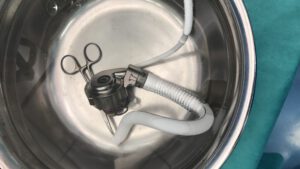In the case of severe heartfailure and other treatments no longer seem to work, patients may qualify for a left ventricular assist device or better known as an LVAD. An LVAD is a mechanical pump that supports or completely replaces the function of the left ventricle.
The HeartMate3 (HM3) made by Abbott
The HeartWare (HVAD) form Medtronic
At the UMC Utrecht there are currently two types of LVAD devices that are implanted, namely the HeartMate3 (HM3) made by Abbott and the HeartWare (HVAD) form Medtronic.
Interesting
The mechanism
These devices work roughly the same as centrifugal continues flow pumps. Blood from the left ventricle is sucked into the Left Ventricle Assist Device (LVAD) ans pumped into the aorta to supply the systemic circulation with blood.
The LVAD is pre-load dependent and afterload sensitive meaning the the patient filling status has to be monitored closely.
The LVAD pump is connected with a driveline to a controller outside the patient which in its turn is connected to a power source. The controller displays different parameters from the LVAD pump; the blood flow (L/min), rotations per minute (RPM), the power (Watt) it is operating by, the Pulsatility Index and the heamatocrit. These paramenters gives the healthcare professional the tools in understanding how well the LVAD is working.
The power source could be either connected to power module or to a battery pack for mobility.
Heartbeat healthcare professionals provide technical support during the implantation fase of the LVAD and help patients and physicians in understanding everyday issues that they may incounter with these high complex devices.



